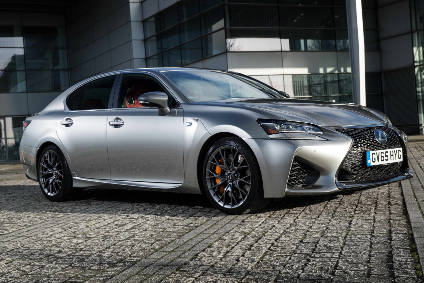
Do we think of Lexus as a performance brand? Not usually. The LF-A was a few years ago now and the RC F is rarely seen on British roads. The newest F is the GS and while it will sell in only the tiniest of volumes, BMW and Mercedes-AMG buyers shouldn’t dismiss it.
Compared to the BMW M5, the GS F is down on power but until Mercedes-AMG adds another derivative above the 401hp E 43 4MATIC, the Lexus’ 478hp (351kW) gives it something of an unexpected, if temporary advantage over the Mercedes super-saloon. The German car has four-wheel drive but the GS F’s power and torque go only to the rear axle and that’s via an eight-speed automatic gearbox. Lexus quotes a 0-62mph time of 4.6 seconds. That’s bettered by both versions of the BMW M5, the standard car taking 4.3 seconds versus 3.9 for the far pricier Competition edition.
Given that the M5 is suddenly part of the old-shape range, the G30 5 Series saloon having been announced to the media on 13 October (and due on sale from February), Lexus finds itself in the unusual position of having the segment’s newest high performance model. The steep £69,995 price will put off some potential owners but it must be said that anyone who wants a car in this class will likely want to be noticed, and to have something very exclusive. The GS F certainly qualifies on those grounds.
Not everyone will be as keen as I am on the F’s styling but there’s no denying that the looks, especially from the front, are drama-filled. The grille is big and aggressive, as are the headlights, and the dark grey 19-inch wheels combined with flared arches and a bodykit lend the side profile quite a menacing stance. At the rear, there’s a carbonfibre decklid wing and four exhaust tips.
The normally aspirated 4,969cc V8 sounds very sexy but don’t think it’s all about the bass. Above 5,000rpm and towards 7,100 where maximum power is developed, it screams as it heads towards the limiter. Maximum torque, which is 530Nm, is also developed at a very un V8-like 4,800rpm. There is an Active Sound Control system which comes into play when you select Sport S or Sport S+ mode. This is also found in the RC F, but in the GS F, the rear seat speakers are also used. It definitely works.
Lexus doesn’t want prospective owners to think that this is a gas guzzler, noting that the engine operates on the Atkinson cycle in everyday running then switches to the Otto cycle for performance driving and cruising at speed. Even with that as a fact, if you drive this car hard, you’ll be unlikely to get above 20mpg. The official Combined figure is 25.2, which was somewhat better than what I saw from mostly city and motorway drives. The VED band is M, and CO2 is 260g/km.

US Tariffs are shifting - will you react or anticipate?
Don’t let policy changes catch you off guard. Stay proactive with real-time data and expert analysis.
By GlobalDataA knob on the centre console gives you the choice of Eco, Normal, Sport or Sport+ so you drive the car in any mode from as quiet as possible to track day. In Eco or normal it’s docile but in S or S+, the F it becomes menacing but never uncivilised. You can get it heading sideways if you floor the right pedal while turning out of a junction but almost instantly the back end comes into line.
Torque Vectoring Differential, which is also fitted to the RC F, is in this car too. It has three operating modes:
- Standard (default)
- Slalom, claimed to make the steering response ‘nimble and and agile’
- Track, improved stability for high-speed circuit driving
I played around with TVD and ended up preferring Slalom as it genuinely improves feel, whereas Track can give you too much feedback in normal driving, leading to irritation – in the same way that the hardened suspension of Sport+ mode is not what you want at the end of a long day.
This being a Lexus, build quality is beyond criticism: the whole car feels as though it will last decades and decades. There is alcantara across the top of dashboard as well as for the headliner and on top of a wide armrest. Despite looking like racing ones (with mock holes for harnesses), the seats are remarkably comfortable, as is the ride for a car with such firm suspension.
This is really only a four-seater, as the transmission tunnel is very wide but the two rear passengers will also feel well treated as unlike in so many other cars, their knees will meet very soft backrests rather than hard plastic.
Summary
Is the GS F worth seventy grand? Maybe. It’s a lot of money. The available performance is spectacular, the handling is hard to fault and only the ride in the two most extreme modes is worthy of serious criticism. If you want a big high performance saloon that looks like nothing else on the road, and which you’ll rarely see another example of, this could be your car.
For Lexus UK, the F is a worthwhile model for continued brand building. Sales are strong, with 2,998 vehicles sold in September and 11,422 for the year to date. Across Europe, ACEA data show that deliveries rose by the same 17% during September, to 6,059 cars and SUVs. For 1 January to 30 September, the gain has been 19% with total sales numbering 34,750.



